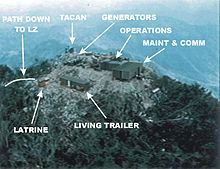10 March 1968 – “During the Vietnam War and the Laotian Civil War, Phou Pha Thi mountain was an important strategic outpost which had served both sides at various stages of the conflict. In 1966, the United States Ambassador to Laos William H. Sullivan approved a plan by the USAF to construct a TACAN site atop Phou Pha Thi; at the time they lacked a navigation site with sufficient range to guide US bomber aircraft to their targets in North Vietnam. In 1967 the site was upgraded with the air-transportable all-weather AN/TSQ-81 radar bombing control system.  This enabled American aircraft to bomb North Vietnam and Laos at night, and in all types of weather, an operation code-named Commando Club. Despite US efforts to maintain the secrecy of the installation, which included “sheep-dipping” of the airmen involved, US operations at the facility did not escape the attention of the PAVN and Pathet Lao forces.
This enabled American aircraft to bomb North Vietnam and Laos at night, and in all types of weather, an operation code-named Commando Club. Despite US efforts to maintain the secrecy of the installation, which included “sheep-dipping” of the airmen involved, US operations at the facility did not escape the attention of the PAVN and Pathet Lao forces.
The defense of Lima Site 85 was assigned to two CIA paramilitary officers who led about 1,000 Hmong soldiers, with 200 men guarding the ridgeline and the remaining 800 in the valley below. They were reinforced by a Thai Border Patrol Police battalion of 300 men. In the first week of 1968, the combined PAVN and Pathet Lao forces probed Royal Laos Army positions in the area by launching several artillery attacks.
By 9 March 1968, the US facility atop Phou Pha Thi was surrounded by PAVN and Pathet Lao units. The PAVN 766th Regiment and one Pathet Lao battalion totaled more than 3,000 men. Despite the gravity of the situation, Sullivan did not issue an order for the evacuation of US personnel from Phou Pha Thi. At around 18:00 on 10 March, Lima Site 85 was subjected to a series of artillery barrages.” (1)
“The force that hit Phou Pha Thi on March 10 consisted of between five and seven battalions, amounting to some 3,000 troops. Mortar, artillery, and rocket rounds began falling about 6 p.m. The enemy was firing on the mountain from the north and east.” Through the night, A-26 bombers and F-4 fighters struck the attackers repeatedly, guided by Blanton’s radar team. Sullivan considered evacuating the site, but the Air Force held to its position of evacuating only as a last resort if the situation became untenable. At about 9:30 p.m., Sullivan decided that nine of the Americans would be brought out at first light the next morning. That, as Sullivan said later, would be “one day too long.”(2)
A Wikivideo documentary about the battle can be seen at this link: https://www.youtube.com/watch?v=x–4GoH82RY
Sources: Wikipedia; (2) AirForceMagazine
